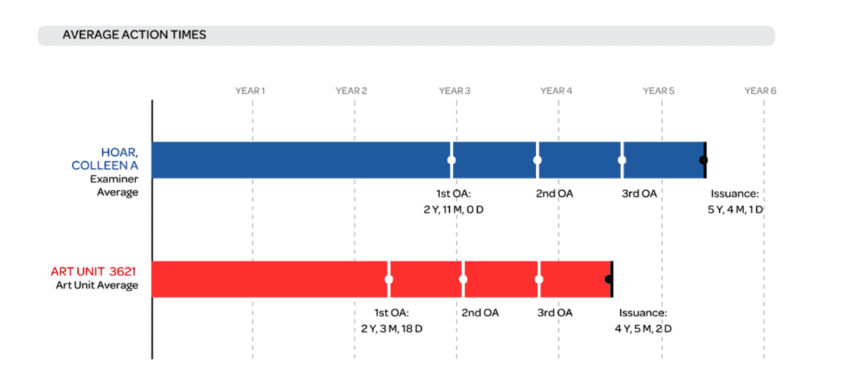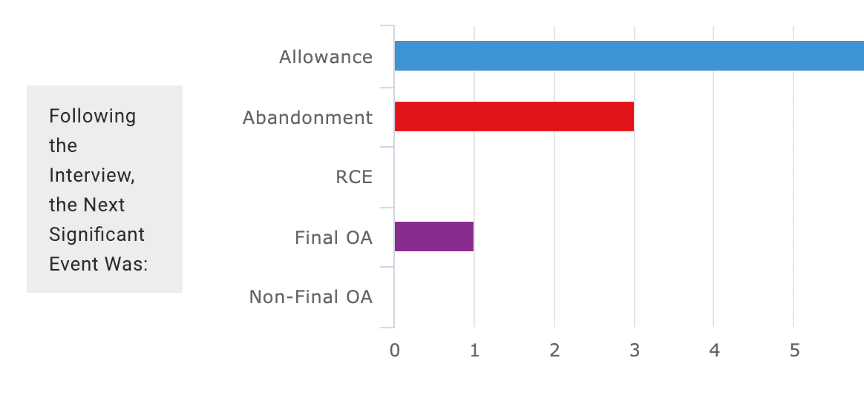Supplement PatentAdvisor ETA™ Predictions With Additional Patent Statistics

Decades ago, when patent authorities like the United States Patent and Trademark Office (USPTO) developed online databases to house their patent records, patent professionals immediately saw the value in processing and interpreting all of the newly available information. Patent data was sliced and diced to gain a better understanding of everything, from USPTO operations, to patent application performance, to the behavior of patent examiners. Eventually, however, it became apparent that, while patent statistics had their place and value, they fell short of predicting patent examiner behavior for several reasons.
One of the biggest problems with patent examiner statistics is that they are typically based on an examiner’s career averages, and therefore fail to reflect how an examiner’s views and decisions have evolved. To compound the problem, many patent statistics are based solely on patent applications that have either been issued or abandoned, and fail to take into account the actions an examiner has taken on applications that are pending. From these issues emerged the PatentAdvisor ETA™, a metric predictive of examiner behavior, available on the LexisNexis PatentAdvisor® patent analytics platform. Each PatentAdvisor ETA value is based on a proprietary algorithm that addresses the shortcomings of ordinary patent statistics, which provides users with a quantified means for assessing an examiner’s relative difficulty level.
The PatentAdvisor ETA metric has since become a user favorite within the PatentAdvisor™ platform, but patent statistics still play an important role in making informed patent prosecution decisions. While standard statistics fall short of predicting an examiner’s behavior, they can still supplement the information gained from PatentAdvisor ETA values to help better understand the examiner they have been assigned.
Patent statistics and prosecution length
While examiner PatentAdvisor ETA values are way more useful than patent statistics for determining a patent examiner’s difficulty level, there is limited information to be gained from a PatentAdvisor ETA regarding how long an examiner will take to examine a patent application. Where PatentAdvisor ETA feedback might inform PatentAdvisor users that there is a “high likelihood” of “long” or “short prosecution length,” it does not provide a quantitative estimate of how long prosecution will take. Fortunately, PatentAdvisor calculates the average prosecution length for all of the patents an examiner has evaluated. Of course, users should understand that default examiner patent statistics are based on career patent data that should be interpreted with a grain of salt, but can still prove useful as guideposts and for managing a client’s expectations for the patent process.

Patent statistics and examiner interviews
To any patent practitioner who does not take patent examiner interview statistics into account in their decisions—it is time to start. Where patent statistics like average prosecution lengths or examiner allowance rates act as supplements for understanding a patent examiner’s PatentAdvisor ETA value, interview statistics reveal the value that previous patent applicants have been able to extract through holding interviews with the examiner. In many cases, patent examiners respond very favorably to patent applicants that pursue interviews—even by occasionally granting a patent immediately after the interview. Only an examiner’s interview statistics can reveal whether an interview is key to getting through to a difficult patent examiner, regardless of their PatentAdvisor ETA value.

Patent briefcase analytics
One of the major issues with using career averages to inform decisions is that those averages fail to reveal an examiner’s behavioral trends. For example, a patent examiner who was slower and more conservative in the early part of their career could have settled into being much more applicant-friendly in recent years. Unlike a PatentAdvisor ETA value, career averages do not necessarily reflect a patent examiner’s more recent (and therefore relevant) decisions. Fortunately, the PatentAdvisor digital briefcase feature provides a way to narrow the scope of an examiner’s patent statistics from career-wide to any time duration a user chooses. PatentAdvisor enables users to assign select patent records to a Briefcase and run patent analytics over only those select records. Users can easily add all of a patent examiner’s evaluated applications to a Briefcase and then use filters to analyze only those applications that were filed or issued within a specific date range. This method allows users to take statistical snapshots of different phases of a patent examiner’s career, so they can better understand the examiner’s past and present behavioral trends.
Patent statistics including prosecution length, examiner interview statistics, and creating a digital briefcase to run patent analytics can all supplement a patent examiner’s PatentAdvisor ETA to help better understand an examiner.
Discover more about PatentAdvisor.
Learn how the PatentAdvisor digital briefcase feature can assist with analyzing and improving patent prosecution performance in Use Digital Briefcases for Patent Portfolio Analytics.
